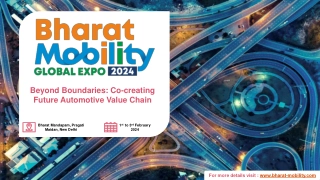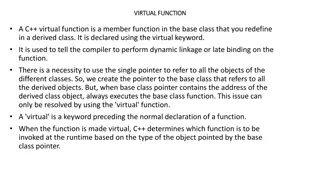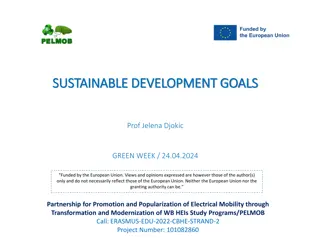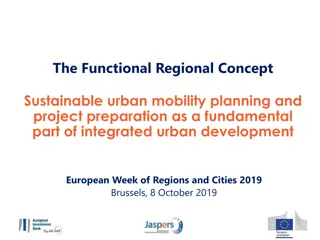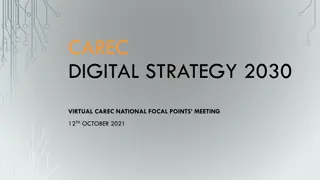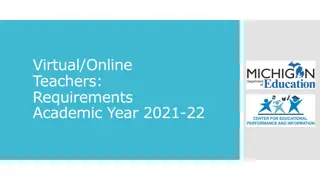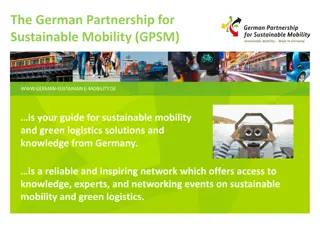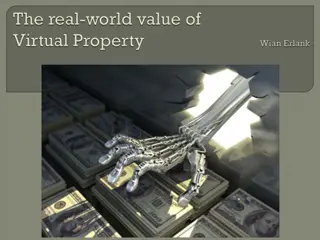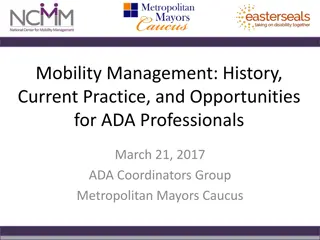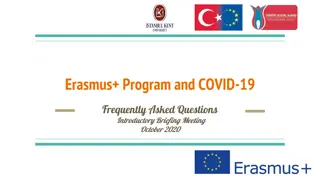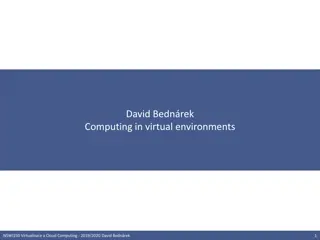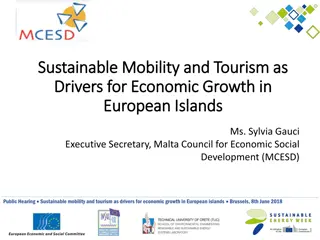Digital & Sustainable Academic Mobility: Virtual Mobility Definitions
Students and staff mobility in the context of Higher Education institutions, emphasizing digitally enhanced (virtual) mobility and the benefits of virtual exchanges. Discusses the use of digital platforms for intercultural dialogue and skills development, and the concept of Virtual Mobility (VM) through ICT-supported activities.
Download Presentation

Please find below an Image/Link to download the presentation.
The content on the website is provided AS IS for your information and personal use only. It may not be sold, licensed, or shared on other websites without obtaining consent from the author.If you encounter any issues during the download, it is possible that the publisher has removed the file from their server.
You are allowed to download the files provided on this website for personal or commercial use, subject to the condition that they are used lawfully. All files are the property of their respective owners.
The content on the website is provided AS IS for your information and personal use only. It may not be sold, licensed, or shared on other websites without obtaining consent from the author.
E N D
Presentation Transcript
DIGITAL & SUSTAINABLE ACADEMIC MOBILITY: 1. Digitally enhanced (Virtual) mobility - Terms and Definitions 2. Types of Virtual Mobility 3. Virtual Mobility Environment 4. Assignment practical part
1. Digitally enhanced (Virtual) mobility - Terms and Definitions Students mobility - a major EU policy priority and a central element of the European Commission s (EC) strategies as presented in many EC publications Mobility - significant contribution in internationalisation of HE institutions, offering students international academic experiences, as well as key skills for improving students employability, personal and professional development, and soft skills Except of student mobility (for studies or for practice) and academic staff mobility - more recently mobilities of administrative or other non-academic staff is being supported
1. Digitally enhanced (Virtual) mobility - Terms and Definitions Virtual exchanges in Higher Education: consist of online people-to-people activities that promote intercultural dialogue and soft skills development available for every young person to access high-quality international and cross-cultural education (formal and non- formal) without physical mobility digital platforms - valuable tool in partially answering the global constraints on mobility (COVID-19 pandemic) help spreading European values in some cases - they can prepare, deepen and extend physical exchanges (can initiate new demand for them)
1. Digitally enhanced (Virtual) mobility - Terms and Definitions Virtual exchanges in Higher Education: take place in small groups and are always moderated by a trained facilitator should be easily integrated into youth projects (non-formal education) or higher education courses
1. Digitally enhanced (Virtual) mobility - Terms and Definitions Virtual mobility (VM): the use of ICT to obtain the same benefits as one would have with physical (traditional) mobility - but without the need to travel type of learning consisting of virtual compoments through an ICT supported learning environment that includes cross- boarder cooperation enhancing intercultural understanding and exchange of knowledge To sum it up: VM = set of ICT supported activities organized at institutional level that realize international collaborative experiences in the context of teaching and/or learning
1. Digitally enhanced (Virtual) mobility - Terms and Definitions The concept of VM - changed during time, according to new educational policies, resources, and most important development of communication and collaboration tools in the early stages of appearance and development - there were limitations about the level of ICT implementation in universities, the costs, and barriers for synchronous communication: Asynchronous Communication (e-mail, e-conference, discussion forum...) Vs. Synchronous Communication (phone call, chat, videoconference...)
1. Digitally enhanced (Virtual) mobility - Terms and Definitions later VM started to partially replace physical mobility there is more preoccupation with the quality of online delivery of content (European projects developed to enrich the know-how in this field) tremendous ICT transformations offered new opportunities to access learning resources and communicate with peers in a virtual environment (Video conferences, webinars, web lectures, podcasting, screen sharing, and even social media are important channels and examples of ICT supported activities)
1. Digitally enhanced (Virtual) mobility - Terms and Definitions Virtual exchange: an important component in a common field with virtual mobility virtual exchange - include learning enhanced by technology, remote learning, but the main difference between them is: virtual exchange - the focus is primarily on people-to- people interaction and dialogue whereas the primary focus in many e-learning programmes is on content in the case of VM- it is not necessary to include student-to- student dialogue VM - can receive help from virtual exchange including those pieces that enhance development of soft skills
1. Digitally enhanced (Virtual) mobility - Terms and Definitions Benefits of VM: For institutions: increasing institutional visibility and internationalisation, with direct effect on international recognition and an increase in the number of students enhancing the quality of the educational processes and of the teaching / academic staff, contributing to the overall increased quality of the academic offer contributing to the development of virtual universities, by enhancing the use of new technologies and pedagogical innovations, and building a common space for learning and research, extended learning communities with experts from outside
1. Digitally enhanced (Virtual) mobility - Terms and Definitions Benefits of VM: For students: lowering mobility costs (on several cases, with not cost on mobility) broadening the educational offer and offering more subjects / fields / topics to choose from, together with different learning approaches (developing multilingualism and language skills development) enriching experiences from cross border collaborations with people with different cultural backgrounds, developing intercultural competencies and soft skills improving digital skills, using different ICT tools for learning, communication, and collaboration flexibilizing the learning process: any time, any place, any pace removing space and time barriers - learning is no longer location dependent developing teamwork abilities and attitudes
2. Types of Virtual Mobility The dynamic character of VM and its continuous transformation and development, together with the various technologies used for it, makes its classification quite challenging... different forms of virtual mobility (1): virtual seminars and courses offered online by different universities virtual teams (when students can work in common projects together with colleagues from different universities and countries) virtual internships
2. Types of Virtual Mobility different forms of virtual mobility (2) related to: International students/staff exchanges: VM - facilitates a physical international exchange (blended learning) VM - realizes an international exchange i.e. the student follows substantial part of a programme at a distance supported by ICT (virtually) International internships: VM - facilitates a physical international internship (blended) VM - realizes an international internships (virtual) International curriculum: VM as a scenario to internationalise a course or its part (chapter, exercise, task, project...), programme, workshop, seminar can be fully virtual or blended
2. Types of Virtual Mobility Another classification takes into account multiple criteria, establishing multiple types of virtual mobility (3): short-term long-term Intermittent (discontinuous) Synchronous or Asynchronous reflects the type of interaction and learning one-campus multi-campus
2. Types of Virtual Mobility VM classification using the most important elements that characterizes a VM (4): Duration of the mobility: Short term (virtual workshops, seminars, summer schools) Long term (full time courses, educational programmes) Level of implementation: Online mobility (all activities take place online) Blended mobility (physical mobility is complemented by virtual mobility) Certification: Formal (with certification and credits) Semi-formal (recognition of credits for some courses) Informal
3. Virtual Mobility Environment (VME) Contains: all learning activities (formal, informal) tools and methods - used to conduct a virtual mobility programme/activity VM has a great potential: to access a wide educational offer, unique and international learning experiences to access to experts, virtual learning environments for collaboration and courses to facilitate an access to research and data - regardless of time and space, and even surpass different language and cultural barriers
3. Virtual Mobility Environment Parts (components) of VME: A. Distance / blended learning B. Virtual learning environments C. Communication processes D. Virtual communities E. Course / curriculum design
3. Virtual Mobility Environment Distance / blended learning A. even if virtual mobility means more than distance / blended learning containing a wide range of international experiences - we can see distance learning = as an instrument that facilitates knowledge building and generates learning learning, communication, and collaboration processes in virtual mobility = take place at distance The great advantage of distance learning (important tool also for lifelong learning): it gives students flexibility, student-centred learning approaches, removing barriers between learning spaces and time, learning in a virtual world in which technological means and the human component cooperate to accelerate and facilitate the acquisition of deep knowledge related to the studied field
3. Virtual Mobility Environment A. Distance / blended learning is a viable and increasingly in demand alternative because it provides access to a well-established learning programme, even if the information source is not in direct (physical) contact with the students is another approach, thoughtfully integrating the use of a wide range of technologies and digital media with traditional - instructor-led classroom activities is also known as hybrid education nowadays, these two terms being used alternatively, referring actually to the same concept
3. Virtual Mobility Environment B. Virtual learning environments refers to a system that provides users with a set of teaching and learning tools designed to enhance learning experiences and to manage educational processes it is widely used to support today s learners with a wide range of tools and course-specific contents
3. Virtual Mobility Environment B. Virtual learning environments the term is also known as: Learning Management System (LMS) Learning Platform (LP) or Educational Platform (EP) in virtual mobility settings - a virtual learning environment (VLE) must be employed to provide a complete learning experience
3. Virtual Mobility Environment B. Virtual learning environments According to other theories in the field - instead of a VLE, a Personal Learning Environment (PLE) must be created or developed by each participant (student) Advantages of using PLE - the most important one is - that students gain the ability to decide on their own learning, especially lifelong learners:
3. Virtual Mobility Environment B. Virtual learning environments PLE: relatively new phenomenon in the e-learning field motivated by: the needs of life-long learners for a system that provides a standard connection to different institutions e-learning systems a response to pedagogic approaches which require that learner s e-learning systems need to be under the control of the learners themselves the needs of learners who sometimes perfom learning activities offline (remote mountainside...etc.)
3. Virtual Mobility Environment B. Virtual learning environments are currently and successfully used to support distance learning by providing access to learning content, in digital format (and access to authoring tools for creating online courses) evaluation and self-assessment tools, synchronous and asynchronous communication, personal space, administrative tools
3. Virtual Mobility Environment C. Communication processes communication and collaboration in virtual mobility environments are ICT mediated processes, with specific levels of interaction and specific barriers
3. Virtual Mobility Environment C. Communication processes According to available analysis on Barriers to communication in distance education (Z. Berge ,2013): there are more barriers identified in communication, which reside in individual characteristics, learning experience and group characteristics there are several types of barriers in communication causing its disruption:
3. Virtual Mobility Environment C. Communication processes barriers: Cognitive distance - the level of knowledge of the individuals that make up the group (the more heterogeneous the group and the greater the cognitive distance, the more difficult communication will be to build knowledge) Contextual distance - the difference between the abstract situation (theory) and real - context situation (practice) Cultural distance - ethnicity, social class, age, gender, religion... Emotional distance - personal feelings about the learning experience Psychological distance - refers to perceptions (feelings) about the closeness or presence of another person when interacting with that person Social distance - affinity, closeness, support
3. Virtual Mobility Environment C. Communication processes Communication in virtual environments - may seem an easy process and, at the same time, a difficult one to achieve Virtual communication misses the basic features of face- to-face communication and of the material world the new communication technologies can extend both synchronous and asynchronous communication, with the support of virtual wide spread reality technologies
3. Virtual Mobility Environment D. Virtual communities (VC) have experienced a great development keeping up with the ongoing technological updates people have built these communities to exchange experiences, to collaborate around common topics of interest, or simply to communicate VC - is a social entity, characterized by social aspects, formed by individuals in a certain type of social relationship which allows the formation of a common identity and an assumed joint reason
3. Virtual Mobility Environment D. Virtual communities (VC) within a VC - members interact through specific technological means, transcending political and geographical boundaries the connection between members is given by the common interest for certain topics, knowledge, and discoveries
3. Virtual Mobility Environment D. Virtual communities (VC) VC - are part of a virtual mobility environment due to technology these communities are not closed (isolated) - but open and flexible VC allow communication and information exchanges which will result in enriching and diverse experiences via collaboration - participants gain a common and assumed understanding of events, being able to anticipate directions for action and to have an approach to similar events in the future VC - can be organized into learning communities or communities of practice
3. Virtual Mobility Environment E. Course / curriculum design Technology-based curriculum design is an important piece of a virtual mobility environment that must meet rigorous quality criteria of design and content in designing online courses - several factors have major impact upon the quality process and organization: support interaction (among students, among teachers, among students and teachers) planning and organization participant motivation and importance the development of metacognitive skills (active learning, development of knowledge and ideas)
3. Virtual Mobility Environment E. Course / curriculum design in an online environment - the didactic relationship changes significantly: the teacher, as a designer of the learning material, is placed outside the didactic relationship with the students, the direct contact with the teacher is replaced by individual study supported by study materials and technologically mediated communication through specific means an important asset for supporting learning in this direction represents the online community developed around the course / programme = through different virtual environments that support communication and information exchange among learners
3. Virtual Mobility Environment E. Course / curriculum design the design of learning materials - based on the premise of physical distance from the teacher, the fact that the student will learn alone and independently, without his direct guidance, replaced only by technology-based communication, either directly with the teacher, or through the self-access materials made available through the learning experiences
3. Virtual Mobility Environment E. Course / curriculum design the courses - must ensure an effective accomplishment of the teaching-learning process - not just to provide content and information but especially - to anticipate possible questions that a student might ask, supporting the development of specific competencies, linked to the objectives of the learning activities
3. Virtual Mobility Environment E. Course / curriculum design based on theoretcial approaches there is a step-by-step model for designing course materials available: the model highlights the 4 most important steps: 1. identifying the needs of the target group 2. needs analysis 3. setting course objectives 4. structuring the material and ending with its own elaboration a team of specialists (pedagogues, technical experts, specialists in the field) contributes to the fulfilment of some didactic and technical requirements - in order to create a course support that will determine the students to learn actively and consciously
3. Virtual Mobility Environment E. Course / curriculum design technology ensures the interactivity and the increased interest of the students for the material - but it does not guarantee that knowledge is assimilated, skills are acquired, or attitudes are developed the online course structure, correctness, and clarity of the support materials are fundamental elements for making a quality product it is very important for these materials = to be translated into the online environment s language (meaning here the specific shape of the resources, adapted to how information should look in an online environment), using the advantage of technology to make them attractive, interactive, with integrated multimedia sequences and self- assessment tests - that generate results (self-evaluation) and personalized feedback the active participation of the student in the learning process is essential criteria for assessing the quality of the offered learning materials
4. Assignment practical part of the training: Virtual mobility diagram the pathway to creat an on-line course: 1. General description of the learning activity 2. Topics / Disciplines 3. Target group 4. Pedagogical approach 5. Tools included (technical aspects) 6. Language
4. Assignment practical part of the training: Virtual mobility diagram the pathway to creat an on-line course: General description of the learning activity 1. here we can define various examples: regular courses (for one semester / intensive / modular) short term courses modules with learning activities virtual exchange these activities can be developed in one university or by collaboration between two or more universities in addition to the specific learning content aiming at developing specific competencies - the activities can be designed to improve transversal competencies, develop language exchange...etc. skills, foster intercultural
4. Assignment practical part of the training: Virtual mobility diagram the pathway to creat an on-line course: 2. Topics / Disciplines the range of fields included in the VM examples is large: Examples: Teacher Training, Sustainable Environment, History, Economy, Medicine, Physics...etc.
4. Assignment practical part of the training: Virtual mobility diagram the pathway to creat an on-line course: 3. Target group students of different educational levels, researchers, and academic / administrative staff
4. Assignment practical part of the training: Virtual mobility diagram the pathway to creat an on-line course: 4. Pedagogical approach (1) the examples can combine - online learning with face-to- face meetings (blended learning), online asynchronous learning using MOOCs (Massive Online Open Courses) or SPOCs (Small Private Open Courses) Collaborative and project-based learning can be used to enhance virtual learning experiences, together with virtual exchange components that improve language skills and encourage intercultural exchange
4. Assignment practical part of the training: Virtual mobility diagram the pathway to creat an on-line course: 4. Pedagogical approach (2) the evaluation is adapted to specific contexts, project-based evaluation, e-assessment, or peer review Qualitative evaluation methods are more specifically used in these cases (rather than quantitative methods of evaluation - do not help in getting to know whether or what works with these new or innovative teaching methods / tools)
4. Assignment practical part of the training: Virtual mobility diagram the pathway to creat an on-line course: 5. Tools included (technical aspects) In a virtual mobility - technology has a tremendous role in successfully implementing a course / learning activity the educational process takes place through a virtual learning environment ensured by each university, starting from Learning Platforms, open-source platforms (Moodle, edX, ILIAS), cloud-based platforms (Microsoft Teams), in addition with video conferencing tools for online activities - different tools for synchronous and asynchronous communication and spaces for collaboration are employed
4. Assignment practical part of the training: Virtual mobility diagram the pathway to creat an on-line course: 6. Language most of the activities are delivered in the organising university s language, but, in some cases, English is also proposed as an additional language or as a delivery language, independent of the university s regular language it is recommended to make clear the prerequisites regarding the course language
4. Assignment practical part of the training: Virtual mobility diagram the pathway to creat an on-line course: Task group work: Use the theoretical background of the on-line training presentation and six steps of the virtual mobility diagram. Prepare a proposal of the on-line course/program reflecting all steps in the mobility diagram. Work in groups (4?). Process the proposal in the form of the powerpoint presentation and present it (presentation per group max. 10 min.). Presentations will take place on 7.September 2023 at 9:30
Referencies: Digitally Enhanced Mobility Civis Handbook on Virtual Mobility avaliable at: civis-virtual-mobility-handbook.pdf Virtual mobility | PPT (slideshare.net) Virtual Exchanges in higher education and youth | Erasmus+ (europa.eu)
Contact: loreta.schwarczova@uniag.sk


